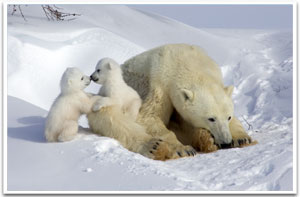Reading One: Polar Bears

Impact: Difficulty getting food
Polar bears hunt ice-dwelling seals. The polar bears walk quietly on the ice to the edge of a seal’s breathing hole in the ice. The bear then waits for the seal to surface for air. This hunting technique takes much less energy for the bear than chasing a seal while swimming. If warmer conditions cause the ice to form later in the fall and break up earlier in the spring, become unstable, or retreat too far from shore, polar bears will have difficulty getting enough food. In fact, if the ice retreats too far from the shore, bears can drown trying to swim out to the ice.
If a female bear doesn’t get enough food, she will have less fat stored to help her have cubs. Underweight females have fewer and smaller cubs that are less likely to survive. When the polar bear mother and cubs emerge from their den in the spring, it will have been between five and seven months since the mother has eaten. She will need to be successful hunting for her family to survive and she needs ice on which to hunt.
Impact: Loss of shelter
In addition to making it more difficult for polar bears to get food, global warming can also directly cause bear deaths. For example, increased number and strength of spring rainstorms can cause bear dens to collapse.
Impact: Barriers to travel
Earlier break-up of sea ice can separate traditional den sites from feeding areas and young cubs would not be able to swim to the feeding areas.
Impact: Competition from newly arrived species
As the climate warms, grizzly bears extend their range to the north. Grizzly bears are more aggressive than polar bears and can out-compete them. They can also interbreed with polar bears, thereby reducing the numbers of non-hybrid polar bears.
Impact: Increased pollution due to climate change
Many of the air pollutants from the industrialized parts of the northern hemisphere reach the Arctic through the circulation of the atmosphere and the flow of water. Climate change is predicted to bring more precipitation (snow and rain) and higher river flows to the Arctic. This will bring more chemical contaminants. Plants and animals that are low on the food chain will absorb these pollutants and then seals will eat them and absorb those pollutants at higher concentrations. Polar bears, at the top of the food chain, will eat seals and absorb the pollutants at even higher concentrations. Pollution stored in polar bears can affect their health, especially when they are already weak from not getting enough food.




